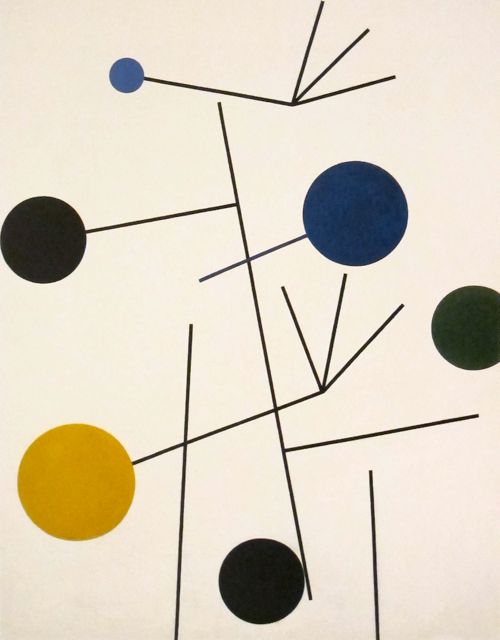Modernism, started around the late 19th century to the early 20th century, is “A deliberate rejection of the styles of the past; emphasizing instead innovation and experimentation in forms, materials and techniques in order to create artworks that better reflected modern society” (Tate), to break from past forms and into new forms of expression; “Modernism was generally based on idealism and a utopian vision of human life and society and a belief in progress” (Tate). Modernism in art is filled with different movements and techniques, such as: Abstract, surrealism, cubism etc.
A form of modernism in fashion, is depicted as “a complex, contradictory,
and sometimes quixotic role in defining the attitude toward the art” (Chadwick
252). Fashion is sexualized and manipulates women figure, wearing corsets to
create exaggerated curves. It became a concern until Wassily Kandinsky
experimented with fashion design to reform the movement. Using abstract
geometric designs, it was “important in identifying women’s fashion as one of
the arenas within which modernist artists, determined to free themselves”
(Chadwick 254). And later, influenced his companion Gabriele Munter. His encouragement
along with painters Jawlensky and Marianne Werefklin, allowed Gabriele to
succeed more in the art of abstract, “Reducing form to simplified color shapes
bounded by dark contour lines” Chadwick 255).
Turning shapes into blocks of color and in a pyramidal form, with bold
prints and translucent colors.
Another form of modernism is cubism. A cubism artist, Sonia Delaunay, who was convinced that “modernity could best be expressed through a dynamic interplay of color harmonies and dissonances which replicated the rhythms of modern urban life” (Chadwick 260). Delaunay worked with textiles and embroidery which allowed her to break down forms and emphasize surface structures (Chadwick 261). Dissatisfied with her artwork as a medium, took a new approach and designed dresses. Due to her designs, it “suggests that the female body itself was being perceived as an important signifier for modernity” (Chadwick 262). It was fashion that expressed abstract and defined modernism to the public. Delaunay quickly became absorbed into the Dada milieu in Paris (Chadwick 270). She was accepted by the Dada group for her art, because Dada lived their life with art. Some of her designs are “set uneasily next to the cultural signs of femininity so that gender and art are shown as social productions” Chadwick 271). Another artist Jean Arp and his wife, Sophie Taeuber-Arp, had been working with Dada ever since 1916. They worked with paper, cloth, embroidery, and other materials to separate themselves from pictorial traditions. With their work, they try to “approach the unfathomable and eternal values of mankind” (Chadwick 272).
Postmodernism
is “specifically a reaction against modernism which
had dominated art theory and practice since the beginning of the twentieth
century. The term postmodernism is also widely used to describe challenges that
changes to establish structures and belief systems that took place in Western
society and culture from the 1960s onward” (Tate). In short it is a reaction
against modernism; not believing that there is one form that defines art, and
embraced complexity in art. Tracey Emin, mediums in neon, embroidery, painting,
film making, drawing, installation, and sculpture. Creates her work based on
personal experiences, such as rape, public humiliation, sexism, etc. She also
uses her own body as a medium. Her work often contested from critique of
expressionism, to the politics of female representation. She rejected the stereotype
of Englishwomen, and was known as a “Bad girl of British art”. She would use
dirty laundry in her work and encouraged honesty in artworks. But she rejects any
notion of her work being feminist for the better, instead, a way to express art
between life and art. Majority of her art was in the concept era, where idea
(or concept) behind the work is more important than the finished art work
(Tate). Within these approaches of modernism and postmodernism, this will
encourage new forms of art in the future as well as increase awareness for
women in art, and art in general.
Tate.
“Modernism – Art Term.” Tate, www.tate.org.uk/art/art-terms/m/modernism.
“Modern Art
(C.1870-1970).” Modern Art: History, Characteristics, Movements, www.visual-arts-cork.com/modern-art.htm
Tate.
“Postmodernism – Art Term.” Tate, www.tate.org.uk/art/art-terms/p/postmodernism.
Tate.
“Conceptual Art – Art Term.” Tate, www.tate.org.uk/art/art-terms/c/conceptual-art.
“Tracey Emin Biography, Art, and Analysis of Works.” The Art Story,
www.theartstory.org/artist-emin-tracey.htm.
Chadwick,
Whitney. Women, Art and Society. Thames and Hudson, 2007.


No comments:
Post a Comment
Note: Only a member of this blog may post a comment.